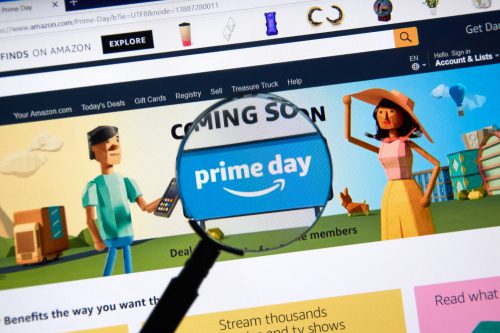 Reading Time: 5 minutes
Reading Time: 5 minutesOne of Amazon’s biggest shopping events of the year, Prime Day, is just around the corner. Back in 2015, Amazon created an exclusive day of deals for Prime members. Since its origin, Prime Day has grown larger and larger every year, with an enormous amount of deals, and millions of shoppers flooding the site.
Prime Day 2018 was record breaking, recording over one million unique deals, and more than 100 million products purchased. This was the largest shopping event in Amazon’s history, surpassing Cyber Monday, Black Friday, and the previous Prime Day. It’s safe to assume Prime Day 2019 will be just as big, if not bigger. Prime Day being such a large event, and traffic on site increasing so drastically, its important as an advertiser to be locked and loaded with all your advertising strategies in order to maximize sales for your brand.
Although the event itself is only about 36 hours, the window of activity for shoppers on Amazon is actually much longer than that. Amazon takes its time announcing the date of Prime Day, but once announced (usually 2-3 weeks prior), Amazon pushes heavy advertisement across dozens of channels to drive awareness for Prime Day. This causes a natural lift in traffic to the site as shoppers begin to browse and research products.
Prime Day Shopper Activity Timeline (Before, During, and After)
You want to begin activating your Amazon Advertising initiatives about 2 to 3 weeks before the anticipated Prime Day date to reach shoppers who are doing some early research. You might be able to convert customers who are making their way onto the site.
Traffic on Amazon will skyrocket for nearly the full length of Prime Day. You want to be sure all your ad campaigns are in peak performance, and fully ramped up when the day hits. You want to ensure that you have maximum visibility when shoppers are going to be most active, which is why it is important to get started a bit early. It is always recommended to allow a minimum of 1 week for Sponsored Ad campaigns to ramp up, as they perform best when they have a bit of data history and traffic behind them already. Getting started early also allows you to begin optimizing daily budget and bid rates. This will help you anticipate the increases you’ll need to make to ensure you are out-bidding the competition, and not running out of budget early.
A key opportunity that is often missed by advertisers, is re-engaging your customers after Prime Day. Amazon sees higher search volume for about 14 days following Prime Day than they see prior. You want to keep campaigns activated in this window to continue to capture interested customers who may or may not have seen your product. This would also be a great time to maximize remarketing audiences for Display Ads (Amazon DSP). You can specifically target all the customers who viewed or searched your product but did not purchase. Sponsored Ads will also help you continue to reach customers you may not have reached before or during Prime Day.
Preparing for Prime Day
Now that you have determined the flighting of your Prime Day campaigns, it’s time to prepare for the big day. There are four key steps/strategies to be armed with to have a successful Prime Day.
- Have all your testing completed
Test your calls-to-action (CTA), creative, keywords, bid rates, etc., in the months leading up to Prime Day. A seasonal event like Prime Day is not a good time to “test things out.” You want to dive into a peak shopping period with your highest performing strategies in place, so do all your testing before. Cost and customer behavior during an event like Prime Day are much different than regular every day activity, so running tests during a seasonal period will skew your results anyway.
- Identify Priorities and Deals
If you want to run a lightning deal, or any other form of promotion on Prime Day, the window for submitting those deals typically ends in May, so you really need to start planning early. Whether you have a promotion running or not, select the products that are going to be your highest priority, typically you or your clients’ best-selling products. Create detailed plans around those products first, including Sponsored Ads, Amazon DSP, Video ads, or a mixture of them all.
Amazon is a great place to sell products, but on a day like Prime Day, the site will be cluttered with thousands of deals, ad placements, and customers. The key to a successful Prime Day is fighting through that clutter. That’s why I recommend Sponsored Ads to be your highest priority channel, to help lift your products in search and gain as much visibility as possible. Your deal may be exactly what customers are looking for, but if your products remain buried in the hard to find deals pages and cluttered search results, you’ll miss out on the opportunity to convert eager customers.
- 3-Phase Bidding and Budget Strategy
Given the amount of search volume on Prime Day, you can anticipate a huge increase in spend. You’ll want to increase your daily budgets for Sponsored Ads to be sure you don’t run out of budget early in the day. It’s recommended to increase your daily budgets by 150% – 200%. In some cases, I have seen Sponsored Ads budgets surpass increases of 400%, so apply a generous increase to your budget, especially your top selling products.
You’ll also want to increase your bid rates to ensure that you out bid your competition. Just as deals will be cluttering Amazon’s pages, so will advertisers, who you can assume will be bumping up bids as well. Following a 3-phased bidding strategy seems to drive the best results that allows for maximum visibility during Prime, but also limits overspend before and after Prime, when traffic is lower. The 3 phases are:
- Increase keyword bids 50% – 100%, 1-2 days prior to Prime Day
- Partial decrease immediately following Prime Day
- Decrease keyword bids down to baseline bid rates after about 14 days, or as you see traffic return down to a stable rate.
Bringing down bids just after Prime Day can be important because you may see your campaigns spend very high amounts, but not driving the return you’d like. Overall traffic on Amazon does decrease rapidly following Prime Day, so bringing down bids slightly will help you battle inefficient overspend. You can also adjust your daily budgets in the same 3-phase strategy or keep them increased for a longer period to be sure you are maximizing on all potential traffic.
- Monitor Your Daily Budgets Hourly (or More)
As I mentioned earlier, the traffic on Amazon increases at such a large scale on Prime Day, you may see your daily budgets spending quicker than anticipated. Even after increasing budgets, you’ll want to check in on them regularly throughout the day. Within the Sponsored Ads system, whether in Seller Central or the Advertising Console for Vendor Central, you should receive Out-of-Budget notifications. Check these regularly, and if you see budgets begin to max out, increase even higher as needed. You don’t want to have a “set and forget” mentality and end up missing out on dozens of sales because your daily budget ran out early. So, monitor your campaigns closely and often.
Being prepared is the only way to have success on an event like Prime Day. Start your planning early and have all your campaigns and bidding strategies ready to execute. The hard part is in the preparation, but with the right plans in place, you can turn Amazon’s biggest day of the year into your biggest day as well.
Check out Vizion’s Amazon Marketing Services and let us help you navigate Amazon Prime Day and beyond.
At Vizion Interactive, we have the expertise, experience, and enthusiasm to get results and keep clients happy! Learn more about how our status as a Google Partner, along with our PPC Management, Google Shopping Ads, Social Media Advertising, Amazon Advertising, and other Paid Media services can increase sales and boost your ROI. But don’t just take our word for it, check out what our clients have to say, along with our case studies.




